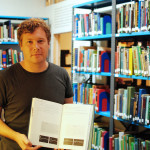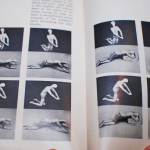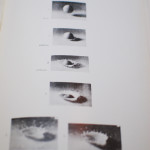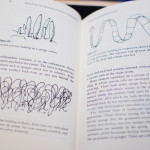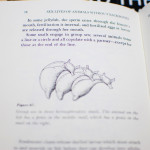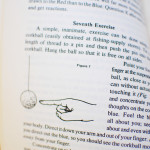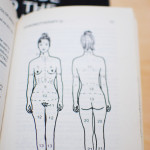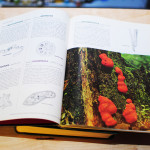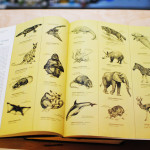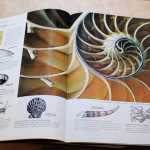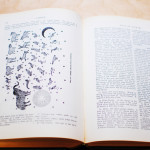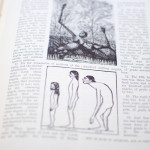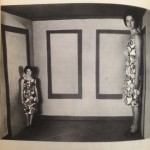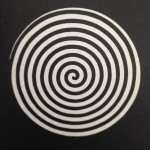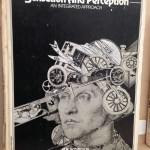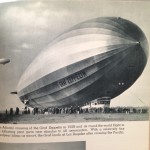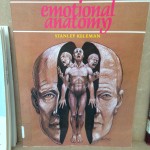Of the countless obscure facts that fill the pages of the Reanimation Library‘s many esoteric volumes, the first that jumps to Andrew Beccone’s mind is about hermaphroditic snail orgies. He slides an open copy of The Sex Lives of Animals Without Backbones across the table. Diagrammed at the center of the page is a daisy-chain of three round slugs curving over each other in flagrante delicto.
“I always think it’s funny that it’s not called something like ‘The Reproductive Strategies of Invertebrates,’” he says. “They must have just wanted to sell more copies.”
With arcane titles like Book of Monsters, Flying Windmills: The Story of the Helicopterand Altered States of Awareness, there’s a certain freak-show quality to the Reanimation Library’s collection. Beccone, a 39-year-old artist, librarian and stay-at-home dad, has spent more than a decade amassing piles of discarded books, rescuing them for their visual imagery. While working as a librarian in St. Paul, Minnesota, he would scour the stacks looking for intriguing images to use in his art projects, mostly xerox-oriented prints in the vein of vintage punk posters. But most libraries, very intentionally, don’t stock the kind of outdated books he was looking for. So Beccone’s private collection grew. He’s now up to about 2,000 books, and the library is open to the public, sharing a space in Brooklyn’s Proteus Gowanus complex since 2006.
The collection consists largely of publications from between the 1940s and the 1970s, which Beccone refers to as the height of modernism. “There’s a belief in technological progress, a sort of utopian belief in it,” he says. “Then of course, at the tail end of that, in the ‘70s, you start to see all these books on nuclear annihilation or books on environmental destruction — the beginnings of a real challenge to the modernist mindset.”
The era isn’t very long ago, but it does, at times, feel like examining some far-flung culture. So much can be gleaned from the thought processes and publication style, how the books are put together and the occasional absurdities — a black-and-white book on color theory, graphic representations of whale sounds, a sex manual that utterly fails to convey reality. “The Art of Sexual Love Making: The images consist of these dolls never actually interacting,” Beccone explains, laughing. “There’s never two of them, so this is totally unhelpful for anyone who’s in 1967 and hoping to learn something.”
As Beccone’s library gained traction, he began setting up temporary “branches.” They have popped up around the city, from the Museum of Modern Art to the current branch at the Queens Museum. He’s taken his library on the road to Philadelphia, Chicago and beyond, even going international with branches in London and Mexico City. When sourcing books for a branch, he usually takes a week to explore the shelves of that city’s used books stores. “I don’t know what kind of books I’m going to find, so there’s this element of chance built in. It’s like this anxiety-producing nightmare for the days leading up to it,” he says.
The Reanimation Library’s next branch will be opening this month in Beirut. “I’m probably also going to encounter a lot of books in Arabic that I won’t know how to read, so that’s going to add a layer of challenge,” Beccone predicts. “I love foreign language books for the fact that when I can’t read the language I can still experience the image. I’m excited to see what sort of material I find in the Middle East.”
While irony and kitsch are certainly a draw, the Reanimation Library is ultimately anthropological in its perspective and Frankensteinian in scope. “You get these sort of jarring gaps in the collection,” Beccone admits. “In the classification scheme there would be some kind of continuity, but because of subjects that I’m not collecting, you have the cooking section here that abuts the knife-fighting stuff.”
Scanning his shelves again for some of the collection’s highlights, Beccone emerges with Oahspe, a massive biblical tome dictated by angels to a dentist in the 1880s. “It doesn’t have a ton of images, but the ones it has are so strange,” he says, opening the volume and fanning pages until he comes to a diagram full of birds, rams and stags amid the stars. “I found this in Florida at some bazaar. It had a Post-It on here, and it just said ‘VERY STRANGE.’”


